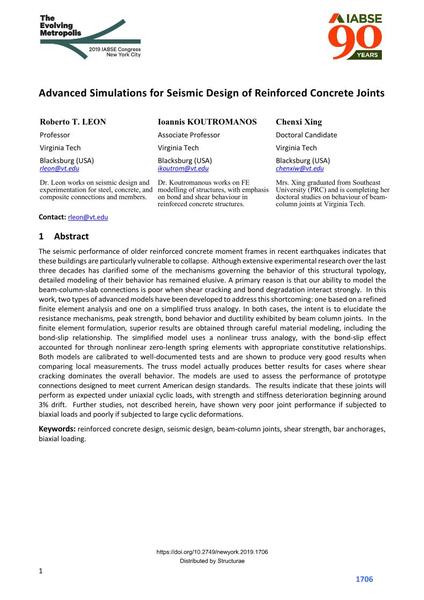Advanced Simulations for Seismic Design of Reinforced Concrete Joints

|
|
|||||||||||
Bibliographic Details
| Author(s): |
Roberto T. leon
(Virginia Tech)
Ioannis Koutromanos (Virginia Tech) Chenxi Xing (Virginia Tech) |
||||
|---|---|---|---|---|---|
| Medium: | conference paper | ||||
| Language(s): | English | ||||
| Conference: | IABSE Congress: The Evolving Metropolis, New York, NY, USA, 4-6 September 2019 | ||||
| Published in: | The Evolving Metropolis | ||||
|
|||||
| Page(s): | 1706-1710 | ||||
| Total no. of pages: | 5 | ||||
| DOI: | 10.2749/newyork.2019.1706 | ||||
| Abstract: |
The seismic performance of older reinforced concrete moment frames in recent earthquakes indicates that these buildings are particularly vulnerable to collapse. Although extensive experimental research over the last three decades has clarified some of the mechanisms governing the behavior of this structural typology, detailed modeling of their behavior has remained elusive. A primary reason is that our ability to model the beam-column-slab connections is poor when shear cracking and bond degradation interact strongly. In this work, two types of advanced models have been developed to address this shortcoming: one based on a refined finite element analysis and one on a simplified truss analogy. In both cases, the intent is to elucidate the resistance mechanisms, peak strength, bond behavior and ductility exhibited by beam column joints. In the finite element formulation, superior results are obtained through careful material modeling, including the bond-slip relationship. The simplified model uses a nonlinear truss analogy, with the bond-slip effect accounted for through nonlinear zero-length spring elements with appropriate constitutive relationships. Both models are calibrated to well-documented tests and are shown to produce very good results when comparing local measurements. The truss model actually produces better results for cases where shear cracking dominates the overall behavior. The models are used to assess the performance of prototype connections designed to meet current American design standards. The results indicate that these joints will perform as expected under uniaxial cyclic loads, with strength and stiffness deterioration beginning around 3% drift. Further studies, not described herein, have shown very poor joint performance if subjected to biaxial loads and poorly if subjected to large cyclic deformations. |
||||
| Keywords: |
seismic design shear strength reinforced concrete design beam-column joints bar anchorages biaxial loading
|
||||
